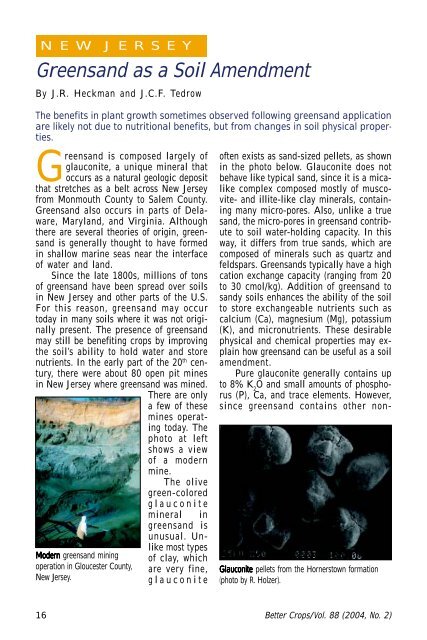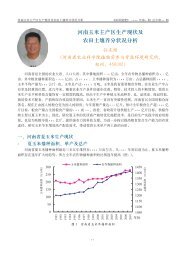Better Crops 2004 #2 - International Plant Nutrition Institute
Better Crops 2004 #2 - International Plant Nutrition Institute
Better Crops 2004 #2 - International Plant Nutrition Institute
Create successful ePaper yourself
Turn your PDF publications into a flip-book with our unique Google optimized e-Paper software.
N E W J E R S E Y<br />
Greensand as a Soil Amendment<br />
By J.R. Heckman and J.C.F. Tedrow<br />
The benefits in plant growth sometimes observed following greensand application<br />
are likely not due to nutritional benefits, but from changes in soil physical properties.<br />
Greensand is composed largely of<br />
glauconite, a unique mineral that<br />
occurs as a natural geologic deposit<br />
that stretches as a belt across New Jersey<br />
from Monmouth County to Salem County.<br />
Greensand also occurs in parts of Delaware,<br />
Maryland, and Virginia. Although<br />
there are several theories of origin, greensand<br />
is generally thought to have formed<br />
in shallow marine seas near the interface<br />
of water and land.<br />
Since the late 1800s, millions of tons<br />
of greensand have been spread over soils<br />
in New Jersey and other parts of the U.S.<br />
For this reason, greensand may occur<br />
today in many soils where it was not originally<br />
present. The presence of greensand<br />
may still be benefiting crops by improving<br />
the soil’s ability to hold water and store<br />
nutrients. In the early part of the 20 th century,<br />
there were about 80 open pit mines<br />
in New Jersey where greensand was mined.<br />
There are only<br />
a few of these<br />
mines operating<br />
today. The<br />
photo at left<br />
shows a view<br />
of a modern<br />
mine.<br />
The olive<br />
green-colored<br />
glauconite<br />
Modern greensand mining<br />
operation in Gloucester County,<br />
New Jersey.<br />
mineral in<br />
greensand is<br />
unusual. Unlike<br />
most types<br />
of clay, which<br />
are very fine,<br />
glauconite<br />
often exists as sand-sized pellets, as shown<br />
in the photo below. Glauconite does not<br />
behave like typical sand, since it is a micalike<br />
complex composed mostly of muscovite-<br />
and illite-like clay minerals, containing<br />
many micro-pores. Also, unlike a true<br />
sand, the micro-pores in greensand contribute<br />
to soil water-holding capacity. In this<br />
way, it differs from true sands, which are<br />
composed of minerals such as quartz and<br />
feldspars. Greensands typically have a high<br />
cation exchange capacity (ranging from 20<br />
to 30 cmol/kg). Addition of greensand to<br />
sandy soils enhances the ability of the soil<br />
to store exchangeable nutrients such as<br />
calcium (Ca), magnesium (Mg), potassium<br />
(K), and micronutrients. These desirable<br />
physical and chemical properties may explain<br />
how greensand can be useful as a soil<br />
amendment.<br />
Pure glauconite generally contains up<br />
to 8% K 2<br />
O and small amounts of phosphorus<br />
(P), Ca, and trace elements. However,<br />
since greensand contains other non-<br />
Glauconite pellets from the Hornerstown formation<br />
(photo by R. Holzer).<br />
16 <strong>Better</strong> <strong>Crops</strong>/Vol. 88 (<strong>2004</strong>, No. 2)

















